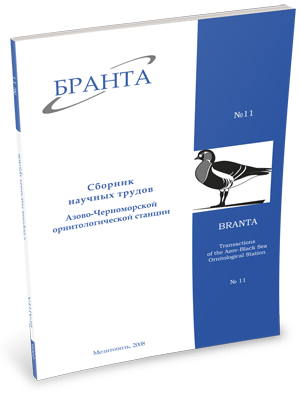
Transactions
of the Azov-Black Sea Ornithological Station



Numbers of the Cormorant in the Dniester Delta
I.T. Rusev
The Dniester River is 1350 km long, including 550 km in Moldova. An average flow of this river is 322 m3/s. It is flooded from 3 to 11 times per year and this is a key factor of functioning of the whole ecosystem. The Dniester Delta is situated in the Odessa Region at the northwest coast of the Black Sea. Reed-marsh complexes occupy the largest area among various habitats in these wetlands (14,000 ha: 63.6%) and provide suitable breeding sites for the birds. Extensive reed-beds occupy 5000 ha (22.7%); flood-land forests bordering the Dniester and Turunchuk rivers – 2200 ha (10.0%); flood-land lakes and oxbows - 3500 ha (15.9%); flood-land meadows - 2000 ha (9.1%). Other types of habitats are of less importance for the breeding birds. Reed-beds alternating with reaches of river and willow shrubs are the most important habitats.
The upper part of the delta belongs to Moldova, it is meliorated and transformed into arable lands. In the lower (Ukrainian) part one of largest wetlands at the Black Sea coast is situated. Its area is more than 220 km.
Within 1977-2008 maximum 4000 pairs of the Cormorant Phalcrocorax carbo were recorded during the breeding period. Numbers of the Cormorant increase first of all due to the spread of the area of fishponds. Other factors affected bird numbers and distribution include: abiotic factors (hydrologic and weather conditions) and anthropogenic factors (fishery, fish-farming (pisciculture), felling of the flood-land forests, water pollution by pesticides and chemicals, water intake for irrigation).
Read the paper in a PDF file